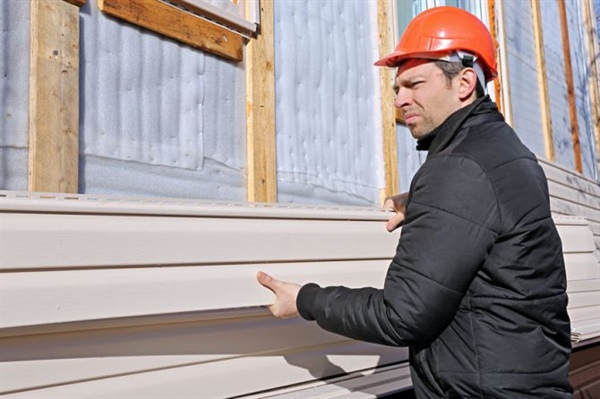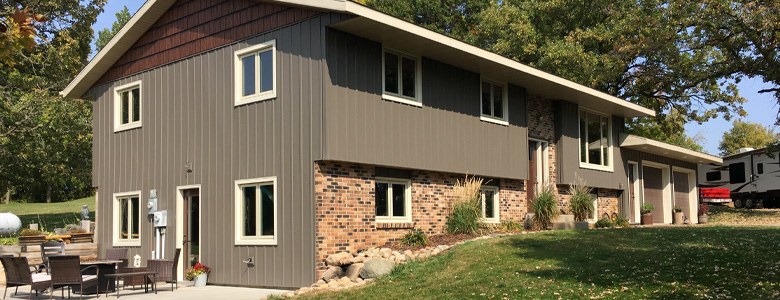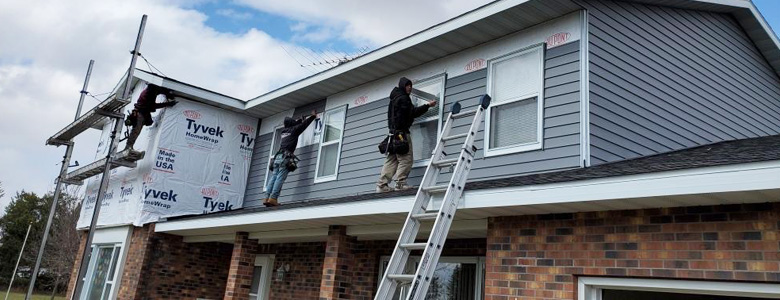How to Make Sure Your Siding Is Waterproof

In the best-case scenario, your siding will be waterproof because of its material; however, if you're dealing with wood, vinyl, or steel without the right maintenance, its durability is compromised.
Water penetration can cause major problems with your home's structural integrity, but by using these trusted methods, you can stop moisture penetration, and here's how!
Siding Isn't Perfectly Waterproof
“How vulnerable is my home, really?” You may be thinking. “It's got siding. Shouldn't that siding be designed to be waterproof?”
Sort of.
Vinyl siding is installed in a series of overlapping planks, and while this system does a great job of ridding your home of water on its own, dampness can still work its way up underneath the planks. This is why many exterior contractors will use an additional barrier underneath a vinyl siding installation to help protect from that additional moisture. Planked steel siding operates in much the same way.
Seamless steel siding, thanks to the relative absence of seams, excels in repelling rain and the elements, giving homeowners worry-free protection. However, just like its planked cousins, the fact that it's installed doesn't mean your home is completely protected; Water can still seep through the connecting points.
All of the above is why the best way to ensure that your siding is waterproofed is to hire a competent siding contractor.
Hire a Competent Siding Company
Check reviews, get quotes – anything you need to do to ensure you get top-notch work.
Once water has compromised your siding, unless it's a simple repair concern, there's not much that can be done to rid your home of it permanently, short of remediation and a brand-new installation job.
As we explained above, the right siding contractor will understand that their materials alone won't guarantee waterproofing. They'll do the legwork to get the job done right and watertight.
-
They will use the proper flashing techniques to redirect water from where exterior features meet.
-
You will see them wrap your home in-house wrap.
-
Caulking (filling up small holes with waterproof paste) should be done sparingly; too much indicates sloppy workmanship.

Keep Up With Storm Damage Repairs
Maybe you didn't budget for that early-season storm or for your siding to be strewn about the yard in shards. However, when bad weather rolls through, and your home doesn't take it well, it needs attention and STAT.
Storm damage often leaves water damage in its wake, and if it's not promptly taken care of, mold colonies can begin to take shape. These are much more expensive to get rid of than a simple siding repair job.
Of course, most people would call storm restoration services if they suddenly found their home siding-less. But for those who see the tiniest crack and decide to put it off, take this as your cue to get on top of things.
Mind Your Sprinkler System
Not only is the systematic splattering of water streams on the side of your home annoying, but it could very well contribute to hard-to-see water damage. As we said, various siding types are installed as interlocking planks. When water is forced up and under those planks by your sprinkler day after day, it's practically a guarantee that you'll encounter water damage at some point or another.
The solution? Water your house-side garden yourself and change the angle of your sprinklers to give your siding a break.
Make Sure Your Gutters Are Clear
No one part of your exterior operates independently of the others. In other words, if one part of your home has water problems, chances are the others will too. This is more true than in the relationship between your siding and gutters.
Gutters are a critical part of your home's moisture management system. After your roof sheds rain, they direct it safely away from your foundation and siding. However, if they're clogged with debris, your gutters will overflow, dripping that water straight down onto your siding.
While your siding is designed to handle rain, it can only do so with the help of a well-working gutter installation, so stay on top of cleaning!
Choose the Right Insulation
While you may have never considered it, your insulation contributes to your siding materials' durability by making them more resistant to moving and warping.
The insulation offers an extra level of protection by creating an extra barrier if moisture does get in, and it can help save you a few bucks on your heating and cooling bills throughout the year.
What If Your Siding Has Taken Damage?
A professional siding job and proper care can keep the material in great condition, but if a harsh Minnesota storm hits, it will become vulnerable. Once the storm has passed, it's a good idea to inspect the exterior of your home and check for damages.
The most common ones to keep an eye out for in your siding are chips, cracks, holes, or dents.
Chips
Chips typically occur from hail, and they might look like a half moon shaped near the edges or areas that have snapped off because of the impact.
Cracks
Long horizontal splits can develop for various reasons, from bad weather to poor installation, and if you're up against cracks in wood, you might consider upgrading to engineered wood siding as a stronger alternative.
Holes or Dents
Most of the time, these occur from hail, but there's also the risk of projectiles in windstorms or neighborhood kids playing too close to the property.
Once you assess the damage, check out your insurance policy to see if you have coverage and find a general contractor that can help you get the repair completed right away.

Call Tony's Lifetime Exteriors for Siding Installation
Staying on top of waterproofing your siding can reduce the impact of damage, and our team has been serving the St Cloud area since 1983 with a strong commitment to providing exceptional craftsmanship and products. From roofing to seamless gutters to siding, we handle everything your home needs to stay in tip-top shape.
Give our Sauk Rapids office a call today at 320-252-9086!